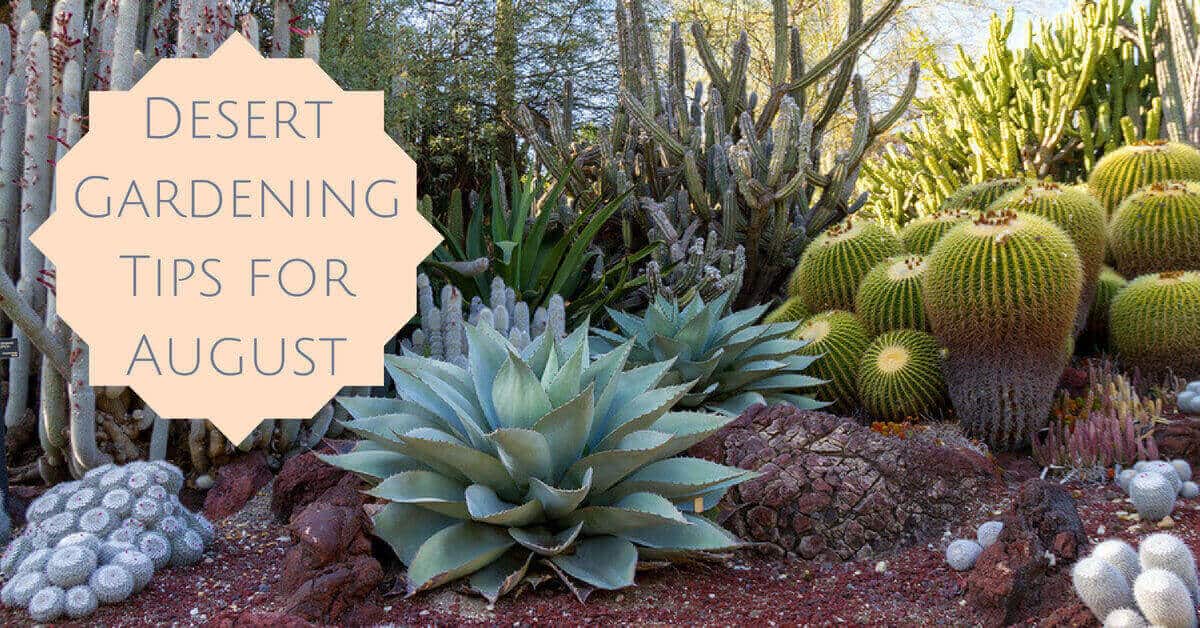- Finding the Right Indoor Plants for Desert Your Home - April 28, 2023
- Common Misunderstanding About Sun Exposure - April 18, 2023
- All about the Arizona Monsoon Season - May 21, 2021
August’s long days and extreme heat can make it a challenging time to maintain a desert garden. Even if you are planting with native plants, each summer season requires observation and adaptability to encourage your garden to thrive and to protect it from threatening conditions.
Summer’s Challenges
August is the heart of the low desert summer. Daytime temperatures regularly hover over 100°F, and monsoons sweep over the plains, providing much-needed water but also raising humidity and encouraging some pests, like mosquitos. With increased urban development and climate change, our night time temperatures are steadily rising, which can cause problems with succulent plants that rely on overnight temperature drops to properly breathe.
Keeping plants well-watered and shaded is key to maintaining their health during summer months
Water Smart
Even for plants adapted to desert conditions, water is essential. Knowing when to water and how deeply to water will keep your plants from stress and damage. An irrigation system is the easiest way to conserve water while keeping your plants nourished. When planning your watering schedule, take into account any rainfall that has occurred. Overwatering plants in the summer can produce damage and rot, so for most native plants the soil should be allowed to dry out between watering.
Cacti are often the easiest plants to maintain in a desert garden. Desert rainfall is most often adequate to meet a cactus’ water needs. If it has gone a month without rain, it is time to water your cactus. Succulents are also often able to subsist on rainfall, but in these hottest months of the year, make sure they are receiving water by rain or irrigation at least twice a month with time to dry in between watering.
Native herbaceous plants and trees are similarly low-maintenance, but will benefit from careful monitoring. If the plants in your garden are established, trees need a deep watering about once a month and herbaceous natives about twice a month. For newly planted additions to your garden, watering needs to be much more frequent- roughly once a week for new trees, or every 2-3 days if temperatures climb above 108°F.
Container gardens will all need watering to stay healthy. Desert adapted plants will require at least 1-2 waterings a month, while vegetables and herbs will need more maintenance to keep growing.
New Planting
Summer is an intense time to plant in the desert, but it desert trees, shrubs and cacti can all be successfully introduced to your garden during this season. Hold off on planting herbaceous perennials until the autumn arrives. Similarly, it is reasonable to start seedlings for autumn vegetable planting but outdoor conditions will be too harsh for introducing young vegetable plants to your garden.
When planting new cacti, keep in mind the direction of the sun. Most desert nurseries will mark pots to indicate the directional orientation a cactus has grown with. Always replant with the sun-hardened side of a cactus in mind. If the direction is unknown, keep a watch on your cacti to make sure they are not being burned. Yellowing is a sign you will need to protect a new cactus with shade cloth until it is better adapted.
Fertilizing
Summer isn’t the best time to fertilize your plants, so if you can wait until the weather cools. The best time of year to fertilize is the beginning of spring. In the hot months of summer, plants need to protect themselves from the harshness of the sun and new growth promoted by fertilizer may be too delicate to survive the heat.
For containers gardens, regular fertilizing will help keep your plants healthy and hearty. Once the summer is over, introducing fertilizer shouldn’t be a problem. Fertilizer improperly applied can burn plants.
CC Sunscreens
Your plants aren’t the only thing that need protection from the sun – August heat can keep you from being happy and healthy too. The solution? CC Sunscreens, stylish custom sunblockers that keep your home cool and comfortable without building up a huge energy bill. The summer is a great time to feel the impact custom sunscreens can have on your home’s comfort and your energy bill. This season, protect your garden, and yourself from sun damage and call CC Sunscreens today!

